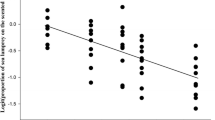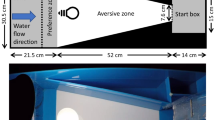Abstract
We used a laboratory behaviour assay to investigate how innate predator recognition, handling stress, retention time, and number of conditioning events might affect chemically mediated anti-predator conditioning for hatchery-reared chinook salmon, Oncorhynchus tshawytscha. Juvenile chinook salmon with no prior exposure to predatory stimuli exhibited innate fright responses to northern pikeminnow, Ptychocheilis oregonensis, odour, regardless of whether the salmon came from a population that exists in sympatry or allopatry with northern pikeminnows. Juvenile chinook salmon exhibited enhanced predator recognition following a single conditioning event with conspecific extract and northern pikeminnow odour. Handling similar to what hatchery salmon might experience prior to release did not substantially reduce the conditioned response. When we conditioned juvenile chinook salmon in hatchery rearing vessels, fish from tanks treated once exhibited a conditioned response to northern pikeminnow odour in aquaria, but only for one behaviour (feeding response), and fish treated twice did not respond. The results suggest that enhanced recognition of predator stimuli occurs quickly, but may be to some extent context-specific, which may limit conditioned fright responses after release into the natural environment.
Similar content being viewed by others
References
Berejikian, B.A. 1995. The effects of hatchery and wild ancestry and experience on the relative ability of steelhead trout fry (Oncorhynchus mykiss) to avoid a benthic predator. Can. J. Fish. Aquat. Sci. 52: 2076–2082.
Berejikian, B.A., R.J.F. Smith, E.P. Tezak, S.L. Schroder & C.M. Knudsen. 1999. Chemical alarm signals and complex hatchery rearing habitats affect anti-predator behaviour and survival of chinook salmon (Oncorhynchus tshawytscha) juveniles. Can. J. Fish. Aquat. Sci. 56: 830–838.
Brown, G.E., D.P. Chivers & R.J.F. Smith. 1997. Differential learning rates of chemical versus visual cues of a northern pike by fathead minnows in a natural habitat. Environ. Biol. Fish. 49: 89–96.
Brown, G.E. & R.J.F. Smith. 1997. Conspecific skin extracts elicit antipredator responses in juvenile rainbow trout (Oncorhynchus mykiss). Can. J. Zool. 75: 1916–1922.
Brown, G.E. & R.J.F. Smith. 1998. Acquired predator recognition in juvenile rainbowtrout (Oncorhynchus mykiss): Conditioning hatchery reared fish to recognize chemical cues of a predator. Can. J. Fish. Aquat. Sci. 55: 611–617.
Brown, G.E., D.P. Chivers & R.J.F. Smith. 1995. Fathead minnows avoid conspecific and heterospecific alarm pheromones in the faeces of northern pike. J. Fish Biol. 47: 387–393.
Chivers, D.P. & R.J.F. Smith. 1994a. The role of experience and chemical alarm signaling in predator recognition by fathead minnows, Pimephales promelas. J. Fish Biol. 44: 273–285.
Chivers, D.P. & R.J.F. Smith. 1994b. Fathead minnows (Pimephales promelas) acquire predator recognition when alarm substance is associated with the sight of unfamiliar fish. Anim. Behav. 48: 597–605.
Chivers, D.P., G.E. Brown & R.J.F. Smith. 1995. Acquired recognition of chemical stimuli from pike, Esox lucius, by brook sticklebacks, Culaea inconstans, (Osteichthyes, Gasterosteidae). Ethology 99: 234–242.
Chivers, D.P. & R.J.F. Smith. 1995. Chemical recognition of risky habitats is culturally transmitted among fathead minnows, Pimephales promelas (Osteichthyes, Cyprinidae). Ethology 99: 286–296.
Collis, K., R.E. Beaty & B.R. Crain. 1995. Changes in catch rate and diet of northern squawfish associated with the release of hatchery-reared juvenile salmonids in a Columbia River reservoir. North. Am. J. Fish. Manage. 15: 346–357.
Gotceitas, V. & J.-G.J. Godin. 1993. Effects of aerial and in-stream threat of predation on foraging by juvenile Atlantic salmon (salmo salar). pp. 35–41. In: R.J. Gibson & R.E. Cutting (ed.) Production of Juvenile Atlantic Salmon, Salmo salar, in Natural Waters, Can. Spec. Publ. Fish. Aquat. Sci. 118.
Healey, MC. & U. Reinhardt. 1995. Predator avoidance in na¨ïve and experienced juvenile chinook and coho salmon. Can. J. Fish. Aquat. Sci. 52: 614–622.
Huntingford, F.A. & R.M. Coulter. 1989. Habituation of predator inspection in three-spined stickleback, Gasterosteus aculeatus L. J. Fish Biol. 35: 153–154.
Johnsson, J.I., J. Hojesjo & I.A. Fleming. 2001. Behavioural and heart rate responses to predation risk in wild and domesticated Atlantic salmon. Can. J. Fish. Aquat. Sci. 58: 788–794.
Kanayama, Y. 1968. Studies of the conditioned reflex in lower vertebrates. X. Defensive conditioned reflex of chum salmon fry in a group. Marine. Biol. 2: 77–87.
Lebedeva, N.Y., M.A.Y Vosilene & R.V. Golovkina. 1994. Aspects of stress in rainbow trout, Salmo gairdneri, release of chemical alarm signals. J. Ichthyol. 33: 66–74.
Magurran, A.E. 1989. Acquired recognition of predator odour in the European minnow (Phoxinus phoxinus). Ethology 82: 216–223.
Magurran, A.E. & S.L. Girling. 1986. Predator model recognition and response habituation in shoaling minnows. Anim. Behav. 34: 510–518.
Mathis, A. & R.J.F. Smith. 1993a. Chemical labeling of northern pike (Esox lucius) by the alarm pheromone of fathead minnows (Pimephales promelas). J. Chem. Ecol. 19: 1967–1979.
Mathis, A., & R.J.F. Smith. 1993b. Fathead minnows, Pimephales promelas, learn to recognize northern pike, Esox lucius, as predators on the basis of chemical stimuli from minnows in the pike's diet. Anim. Behav. 46: 645–656.
Maynard, D.J., A.L. LaRae, G.C. McDowell, G.A. Snell, T.A. Flagg & C.V.W. Mahnken. 1998. Predator avoidance training can increase post-release survival of chinook salmon. pp. 59–62. In: R.Z. Smith (ed.), Proceedings of the 48th Annual Pacific Northwest Fish Culture Conference, Gleneden Beach, OR.
Mesa, M.G. 1994. Effects of multiple acute stressors on the predator avoidance ability and physiology of juvenile chinook salmon. Trans. Am. Fish. Soc. 123: 786–793.
Mesa, M.G., T.P. Poe, D.M. Gadomski & J.H. Petersen. 1994. Are all prey created equal? A review and synthesis of differential predation on prey in substandard condition. J. Fish. Biol. 45 (Suppl. A): 81–96.
Metcalfe, N.B., F.A. Huntingford & J.E. Thorpe. 1987. The influence of predation risk on the feeding motivation and foraging strategy of juvenile Atlantic salmon. Anim. Behav. 35: 901–911.
Mirza, R.S. & D.P. Chivers. 2000. Predator-recognition training enhances survival of brook trout: evidence from laboratory and field-enclosure studies. Can. J. Zool. 78: 2198–2208.
Olla, B.L. & M.W. Davis. 1989. The role of learning and stress in predator avoidance of hatchery-reared coho salmon (Oncorhynchus kisutch) juveniles. Aquaculture 76: 209–214.
Patten, B.G. 1977. Body size and learned avoidance as factors affecting predation on coho salmon fry by torrent sculpin (Cottus rotheus). Fish. Bull. 75: 451–459.
Smith, R.J.F. 1992. Alarm signals in fishes. Rev. Fish Biol. Fish. 2: 33–63.
Suboski, M.D. 1988. Acquisition and social communication of stimulus recognition by fish. Behav. Process. 16: 213–244.
Thompson, R.B. 1966. Effects of predator avoidance conditioning on the postrelease survival rate of artificially propagated salmon, Ph.D. Thesis, University of Washington, Seattle, WA.
Welch, C. & P. Colgan. 1990. The effects of contrast and position on habituation to models of predators in eastern banded killifish (Fundulus diaphanous). Behav. Process. 22: 61–71.
Author information
Authors and Affiliations
Rights and permissions
About this article
Cite this article
Berejikian, B.A., Tezak, E.P. & LaRae, A.L. Innate and enhanced predator recognition in hatchery-reared chinook salmon. Environmental Biology of Fishes 67, 241–251 (2003). https://doi.org/10.1023/A:1025887015436
Issue Date:
DOI: https://doi.org/10.1023/A:1025887015436




